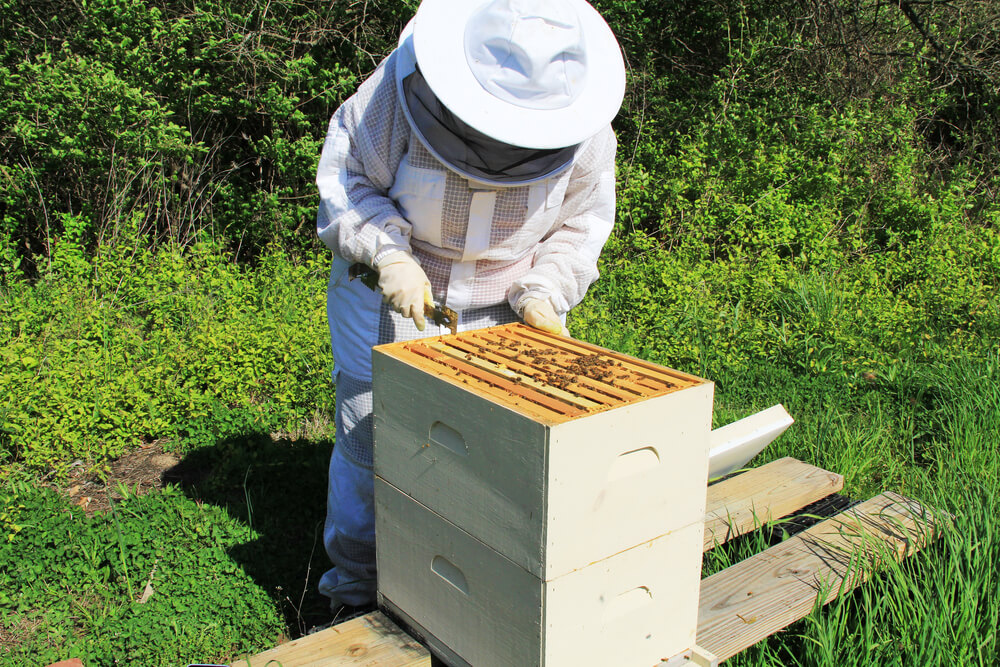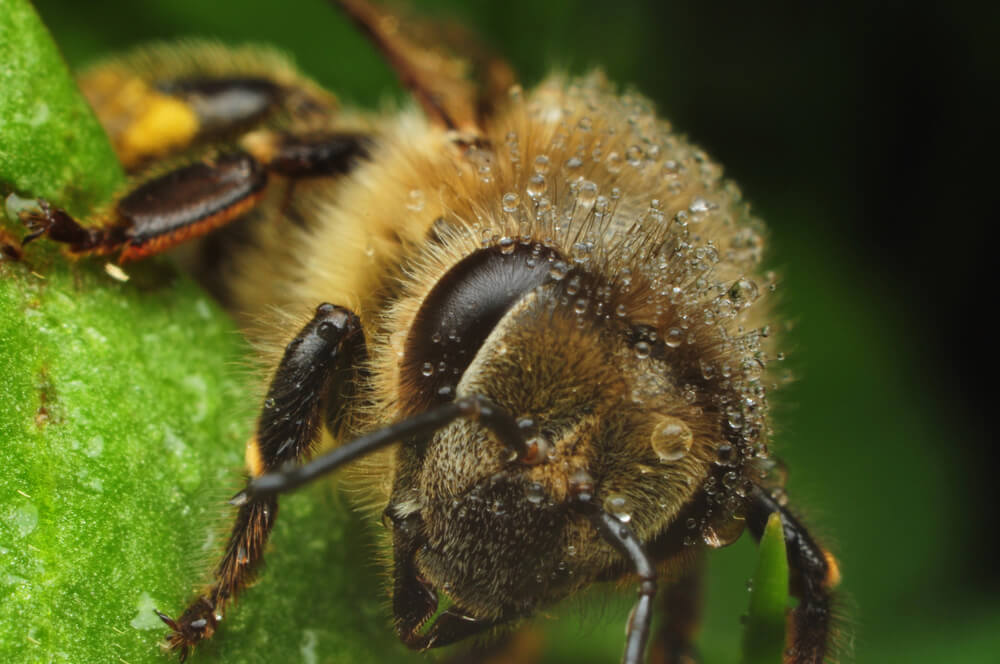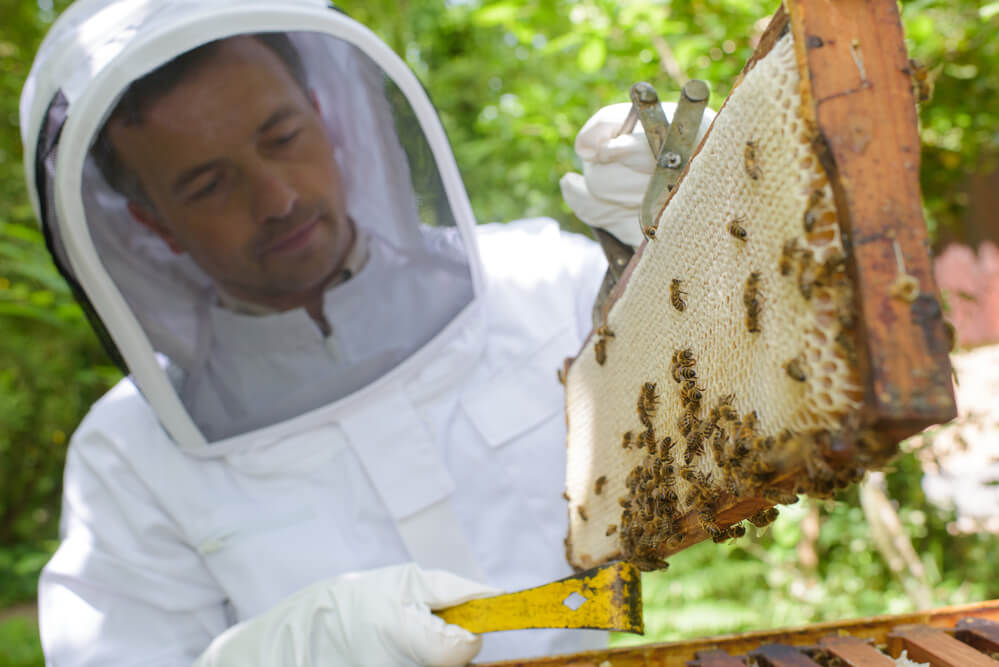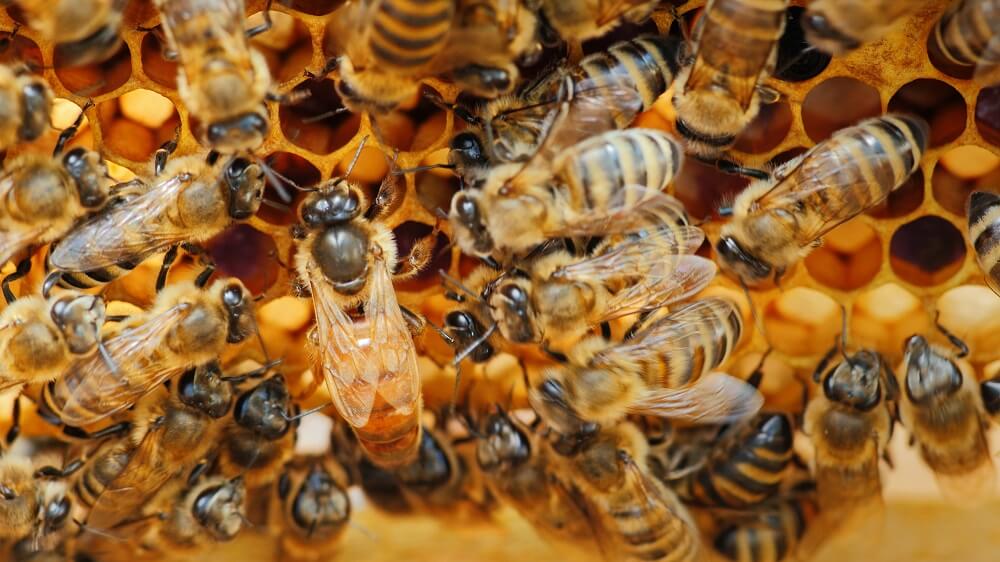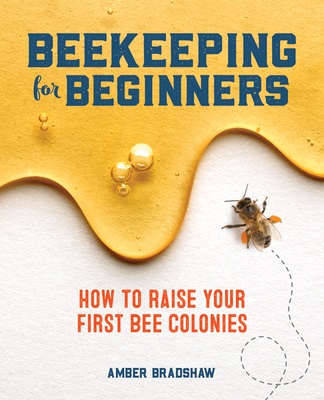Table of Contents:
What Are Modern Hives?

Modern hives, also called Langstroth hives, are the most common hive used by beekeepers today.
A beekeeper named Lorenzo Langstroth invented them in 1852. They consist of a series of stacked boxes, each with its own frames. The frames hold the beeswax comb, which the bees use to store honey and pollen.
Why are these Langstroth hives so popular?
A few reasons.
One reason is that the beekeeper can easily move the Langstroth frames since the honeybees build their honeycomb inside them. This lets the beekeeper inspect the hive without damaging the comb and harvest honey without harming the bees.
Better yet?
Langstroth hives are also easier to transport than other types of hives, making them the preferred choice for commercial beekeepers.
With that said, modern hives aren’t ideal for every beekeeper. Like anything else, they come with their own set of pros and cons. Let’s discuss a few.
What Are the Advantages of Modern Hives?
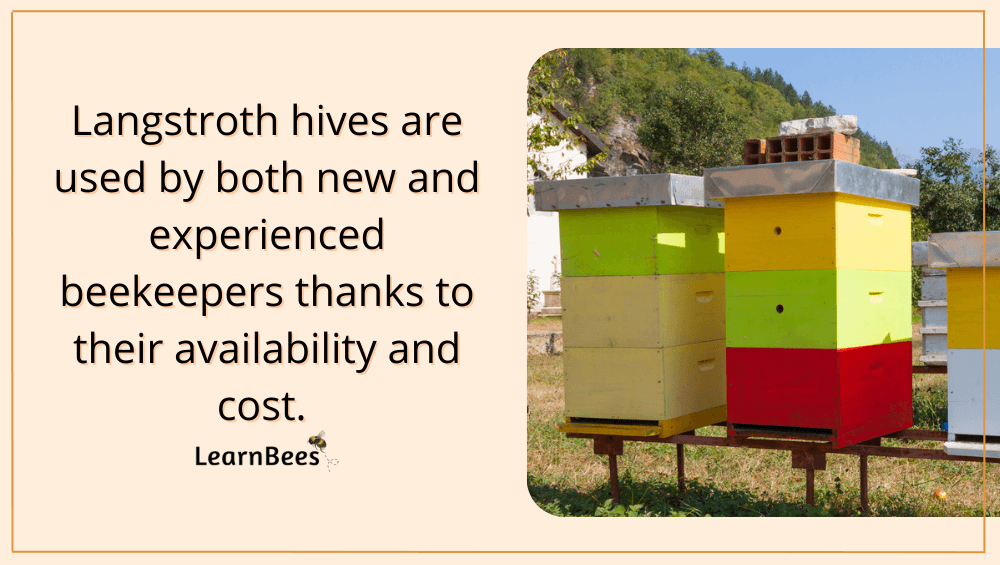
Langstroth hives are the most popular type of hive amongst beekeepers. As such, they’re widely available and reasonably priced.
But what are the specific benefits of these modern hives?
Advantage #1: They Have the Greatest Honey Yield Potential
Langstroth hives are designed to maximize honey production.
The Langstroth beehive is the best type of beehive for honey production because the boxes are large and easy to add. Depending on the honey flow, Langstroth hives can have one, two, or even more honey supers.
In contrast, top bar hives have a fixed size that produces a modest amount of honey – perfect for beekeepers who want enough honey to share with friends and family.
Warre hives fall somewhere in between Langstroth and top bar hives when it comes to honey production.
Advantage #2: Most Beekeepers Use Langstroth, So Getting Advice is Easier
Since the Langstroth is the most popular type of hive, it’s also the type of hive that most beekeepers are familiar with.
This means if you ever have a question or problem with your hive, it’ll be easier to find a local beekeeper who can help you.
Plus, most beekeeping books are written from the perspective of using Langstroth hives – which is especially helpful if you’re a new beekeeper.
Advantage #3: Expanding or Moving Your Hive is Easier
As your hive grows, it’s easy to add more boxes. More boxes equal more honey.
In a nutshell:
Langstroth hives are built to maximize honey yield and minimize drone production. However, you can override this by using foundationless frames in your hive. This way, you also have more freedom to do what works for you.
Additionally, Langstroth hives are easier to stack and move around. If you have several hives that you must move, Langstroth hives are the best choice. When compared to a top bar hive, Langstroth hives are easier to relocate because they come apart neatly.
Advantage #4: Langstroth Equipment is Readily Available
Since the Langstroth is the most popular hive, you can find just about any type of equipment you need for it.
Additionally, Langstroth hives are fairly uniform in shape and size. There may be some variations from one manufacturer to the next, but, in most cases, you can make one piece of equipment work with another.
This is because almost all Langstroth hives are built to the same specifications, so most of the different suppliers have parts that are interchangeable. This also means that you can save money by buying equipment used or on sale since there are so many Langstroth parts available.
Advantage #5: You Can Raise Queens and Collect Pollen or Propolis Easier
Raising queens in other types of hives can be harder because it’s difficult to sequester the active queen from the rest of her colony.
In Langstroth hives, queen rearing is much easier, as well as collecting propolis and pollen.
What Are the Disadvantages of Modern Hives?
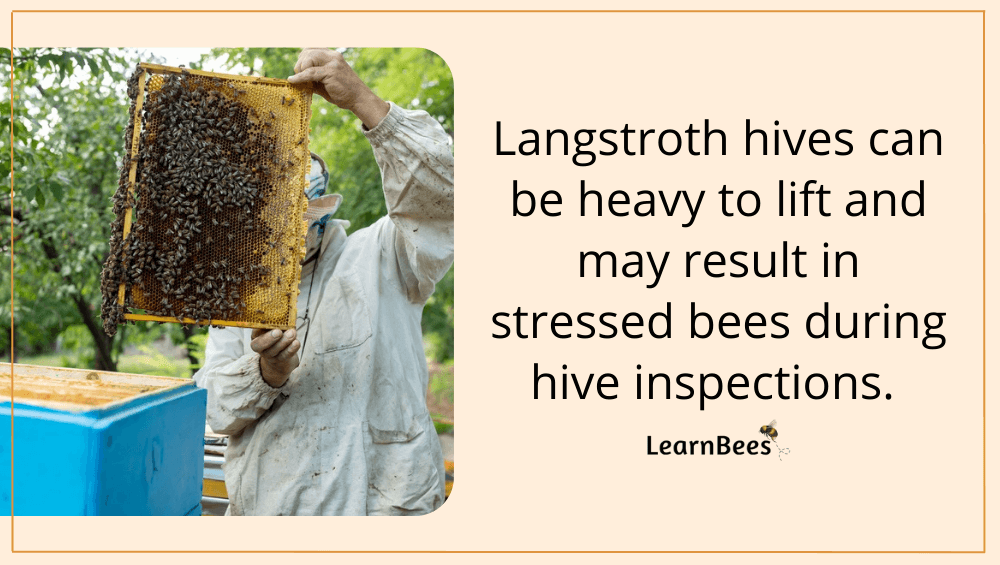
Langstroth hives aren’t a one-size-fits-all for every beekeeper. Depending on your goals and limitations, you may feel that the cons outweigh the pros.
Disadvantage #1: Langstroth Hives Are Heavy
The Langstroth hive is made up of several boxes, each filled with honey and wax comb. The hive can get up to 100 pounds when these boxes are filled.
You can use 8-frame boxes instead of the standard 10-frame boxes, or you can try all medium supers and avoid the deeps altogether. But either way, you’ll likely still have to lift 60-pound boxes eventually.
As a result, you should consider your physical strength when deciding whether or not to invest in a Langstroth hive. Lifting heavy boxes may not be a problem when you’re young and strong, but as beekeepers age, this becomes one of the key reasons they stop keeping bees.
Additionally, keep in mind that beekeeping season occurs during warmer months, so you’ll be lifting heavy boxes in the sweltering heat, depending on your climate.
And, of course, if you have back problems or other health concerns, a Langstroth hive may not be the best choice for you.
Disadvantage #2: Hive Inspections Are More Stressful on Bees
To inspect the lower boxes, you must remove the upper boxes, which can stress your bees out.
Also, when the boxes are placed back on, you might accidentally crush bees that are in the way, which causes even more stress to the hive.
In comparison, top bar hives are less disruptive to the colony and tend to result in happier bees. In a top bar hive, you lift the lid without exposing the entire hive. From there, you take out one bar at a time, inspect it, and replace it to reseal the hive.
FAQs on Modern Hives
- How do you make a modern beehive?
- What is the most commonly used type of artificial hive?
- What are the advantages of a modern beehive?
- What are the disadvantages of modern beehives?
- When was the modern beehive invented?
- What are the types of beehives?
- What is the difference between modern and traditional hives?
- What are man-made beehives called?
- How is a modern bee hive better than a traditional bee hive?
- How tall is a deep super?
- Can you put a modern beehive in the woods?
How do you make a modern beehive?
Building a Langstroth hive is a fairly simple process that anyone with carpentry skills can do. You’ll need to purchase some supplies, including things like wood, paint or stain, and a queen excluder.
With that in mind, we recommend watching this video on how to build the modern hive:
—> Go back to the FAQs on modern hives
More to Explore:
What is the most commonly used type of artificial hive?
The Langstroth hive is the most popular type of man-made hive, and it’s used by beekeepers all over the world. Rev. Lorenzo Langstroth patented the design in 1852, and it’s been the standard ever since.
It’s a great hive for beekeeping, as it’s easy to use and maintain. Plus, it’s very versatile, as you can add or remove frames as needed. Additionally, since the Langstroth hive is so popular, many resources and support are available for beekeepers who use this type of hive.
—> Go back to the FAQs on modern hives
More to Explore:
What are the advantages of a modern beehive?
There are several advantages to using a Langstroth hive, including the following:
- The hive is easy to use and move if needed
- Seeking advice and support is easy, as there are many resources available
- Parts and equipment are widely accessible and affordable since it’s the most popular type of hive
- You get a great yield of honey with this type of hive
—> Go back to the FAQs on modern hives
More to Explore:
What are the disadvantages of modern beehives?
While there are many advantages to using a Langstroth hive, there are also some disadvantages, including the following:
- The hive can be heavy and difficult to move, especially when full
- Inspecting the hive can be disruptive to the bees and may cause them stress
- If you’re not careful, you may accidentally crush bees when placing the hive boxes back on
—> Go back to the FAQs on modern hives
More to Explore:
- How Many Bees Are in a Hive?
- What is Backyard Beekeeping?
- Honey Extractors 101: Everything You Need to Know
When was the modern beehive invented?
Rev. Lorenzo Langstroth invented the modern beehive in 1852. He was a beekeeper that created a beehive with removable frames, which made it much easier to inspect and harvest honey.
He became a beekeeper after seeing honeycomb in a large glass globe on a friend’s table. From there, he devoted himself to understanding bees and their habits. After years of research, he invented the Langstroth hive, which revolutionized beekeeping.
As a result, he is known as the “Father of American Beekeeping.”
—> Go back to the FAQs on modern hives
More to Explore:
What are the types of beehives?
The three most popular types of hives are the Langstroth hive, top bar hive, and Warre hive.
The Langstroth hive is the most popular type of hive and is used by beekeepers all over the world. It’s easy to use and maintain, and it’s very versatile. It’s convenient to use because you can add or remove boxes as needed.
The top bar hive is a more natural way of keeping bees, and it’s becoming more popular among beekeepers. It’s the most comfortable design for beekeepers and bees. Additionally, it’s less likely to crush bees when you’re inspecting the hive.
The Warre hive resembles a Langstroth hive. An important distinction with the Langstroth is that new boxes are added beneath the existing boxes, rather than on top.
The Warre hive was designed to mimic a bee’s natural habitat as closely as possible.
—> Go back to the FAQs on modern hives
More to Explore:
- Queen Cells 101: What They Are & How to Handle Them
- What is Festooning?
- What Are the Langstroth Hive Dimensions?
What is the difference between modern and traditional hives?
The biggest difference is that traditional hives used to be made from dry hay or grasses and hung on a tree or other objects. Additionally, some traditional hives were made from wooden, metal, or clay barrels.
Modern hives are typically made from wood and plastic. It’s much easier to harvest honey from modern hives since they have removable frames. You can add or remove boxes as needed, making them more versatile.
—> Go back to the FAQs on modern hives
More to Explore:
What are man-made beehives called?
There are three main types of man-made hives: Langstroth hives, top bar hives, and Warre hives.
The Langstroth hive is the most well-known and used hive in the United States. It’s a popular choice amongst beekeepers because it’s easy to move, use, and maintain. Plus, it’s very versatile, as you can add or remove boxes as needed to increase honey production
The top bar hive is a more natural way of keeping bees, and it’s becoming more popular among beekeepers. It’s the most comfortable design for beekeepers and bees. Additionally, it’s less likely to crush or upset bees when you’re inspecting the hive.
The Warre hive is designed to mimic a bee’s natural habitat as closely as possible. It uses top bars instead of frames and mirrors a bees natural environment.
—> Go back to the FAQs on modern hives
More to Explore:
How is a modern bee hive better than a traditional beehive?
While there are many differences between modern and traditional bee hives, some of the main advantages of a modern hive include the following:
- They’re easier to inspect and harvest honey from
- They’re more versatile and can be easily customized
- They’re less likely to crush or upset bees during inspections
—> Go back to the FAQs on modern hives
How tall is a deep super?
The deep super is typically 9 5/8 inches tall. This size is ideal for honey production since it allows bees to store a large amount of honey.
—> Go back to the FAQs on modern hives
Can you put a modern beehive in the woods?
Yes. But as with any location, you need to consider the pests, predators, damage and potential theft you may experience. Another key point is whether the location has enough food and water resources for the bees.
